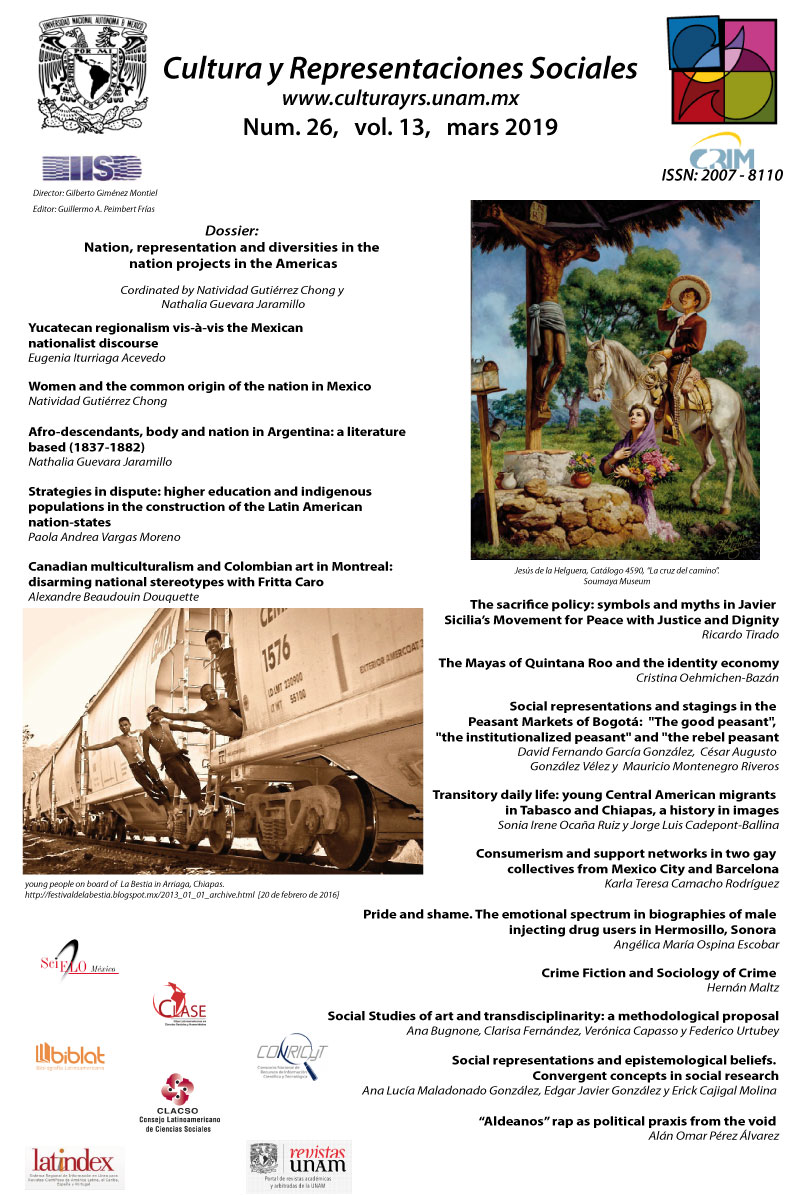Abstract
This article explores the powerful influence of sexuality and gender roles in controlling national identity and nationalism. Thus, the purpose is to review the common origin of the Mexican nation and how women, throughouthistory, have contributed to it. The article is organized into three sections. The first identifies the main types of nationalism in Mexico and their interrelationship
with the gender roles and nationalisms as raised by Floya Anthias and Nira Yuval-Davis in 1989. The second highlights how both nationalism and gender roles contribute to the construction of masculinity and femininity. The third explores gender roles and their different levels of subordination in contemporary
nationalist mythology, particularly the myth of mestizaje (miscegenation) as the founding couple of the modern nation. To exemplify the argument, some unconventional sources were used, such as the popular calendars of the
first decades of the twentieth century, and a narrative on the myth of mestizaje written by a Spanish writer who lived in Mexico in 1884.
References
Anderson, Benedict. (1990). Imagined Communities, Reflection on the Origin and Spread of Nationalism, London and New York: Verso.
Anthias Floya and Yuval-Davis Nira (ed). (1989). Woman-Nation-State Basintoke: Macmillan.
Arrom, Silvia Marina. (1985). The Women of Mexico City, 1790 – 1857. Stanford University Press.
Boudieu, Pierre. (1991). Language and Symbolic Power. Cambridge: Polity Press.
Bordieu, Pierre. (1999). La dominación masculina. Barcelona: Anagrama.
Cusack, Tricia. (2000). “Janus and Gender: Women and the Nation’s Backward look”, en Nations and Nationalism 6:4.
De Barbieri, Teresita. (1992). “Sobre la categoría de género. Una introducción teórico-metodológica” Revista Interamericana de Sociología, año VI, mayo-diciembre.
Díaz del Castillo, Bernal. (1974). Historia de la conquista de la Nueva España. Porrúa: México.
Declaración Universal de Derechos Humanos y otros instrumentos internacionales de derechos humanos [en línea], Disponible en <http://es.wikipedia.org/wiki/FIAN>
Enloe, Cynthia. (1989). Bananas, Beaches and Bases: Makin Feminist Sense of International Politics. Pandora, London.
Espinosa Elia. (2004). Jesús Helguera y su pintura, una reflexión. México: UNAM.
Franco, Jean. (1989). Plotting Women: Gender and Representations in Mexico. Verso: Londres.
Gellner, Ernst. (1983). Nations and Nationalism. Ithaca: Cornel University Press.
Gimeno de Flaquer, Concepción. (1984). “La inspiradora de Cortés”, El albun de la mujer, Año 2, Tomo 3, No. 11, 14 de septiembre de 1884.
Glantz, Margo (ed). (1994). La Malinche: sus padres y sus hijos. México: Facultad de Filosofía y Letras UNAM.
Gutiérrez Chong, Natividad. (1999). Nationalist Myths and Ethnic Identities. Indigenous Intellectuals and the Mexican State. Lincoln and London: Nebraska University Press.
Gutiérrez Chong, Natividad, (coord.). (2004). Mujeres y Nacionalismos en América Latina: De la Independencia a la Nación del Nuevo Milenio. México: Instituto de Investigaciones Sociales, UNAM.
Gutiérrez Chong, Natividad. (2010). “Identidad nacional y sufrimiento colectivo. Arquetipos femeninos en la construcción del heroísmo”. Iconos. Revista de ciencias sociales, 14, (37): 149 -159.
Gutiérrez Chong, Natividad. (2008). “Symbolic violence and sexualities in the myth making of Mexican national identity”, Ethnic and Racial Studies, 31 (3): 524 – 542.
Gutiérrez Chong, Natividad (2006). “Patriotic Thoughts or Intuition: Roles of Women in Mexican Nationalism”, Nations and Nationalism. Special Issue Vol. 12 (2): 339 – 358.
Gutiérrez Chong, Natividad. (2000). “Mujeres-Patria-Nación”, Revista de Estudios de Género La Ventana, Universidad de Guadalajara (12): 209-243.
Leoussi, Athena (ed). (2001). Encyclopaedia of Nationalism. New Brunswick and London: Transaction Publishers.
Lorber, Judith y Susan A. Farell (comps). (1991). The Social Construction of Gender. Sage: Londres.
Mancero Villagómez, Luis. (1949). “Mariana de Jesús: Heroína Nacional”, en La Bandera de Cristo Rey, Año, XXXII, Guayaquil.
Morales Carrillo Alfonso. (2001). “La patria portátil: 100 años de calendarios mexicanos”, Museo Soumaya, La leyenda de los cromos. El arte de los calendarios mexicanos del siglo xx en Galas de México. México, 8 – 34.
McClintock, Anne. (1995). Imperial Leather, Race, Gender and Sexuality in the Colonial Contest. New York and London: Routledge.
Moss George L. (1985). Nationalism and Sexuality, Middle Class Morality and Sexual Norms in Modern Europe. Madison: University of Wisconsin Press.
Museo Soumaya. (2001). La leyenda de los cromos. El arte de los calendarios mexicanos del siglo XX en Galas de México. Segunda edición, México.
Organización Internacional del Trabajo (OIT). (1989). Convenio 169 sobre pueblos indígenas y tribales en países independientes.
Parker, Andrew, Russo, Mary, Summer, Doris and Yaeger Patricia, (eds). (1992). Nationalisms and Sexualities. New York and London: Routledge.
Renan, Ernst . (1998). ¿Qué es una nación?. Madrid: Alianza Editorial.
Schnapper, Dominique. (2001). La comunidad de los ciudadanos. Acerca de la idea moderna de nación. Madrid: Alianza Editorial.
Smith, Anthony D. (1986). The Ethnic Origin of Nations. Oxford: Basil Blackwell.
Smith, Anthony D. (1991). National Identity. Reno: University of Nevada Press.
Stern, Steve J. (1985). The Secret History of Gender. Women, Men and Power in Colonial Mexico. Chapel Hill and London: The University of North Carolina Press.
Teun A. van Dijk. (2003). Dominación étnica y racismo discursivo en España y América Latina. Barcelona: Gedisa Editorial.
Vestina (seudónimo). (1984). “Crónica Mexicana”, El albun de la mujer, año 2, tomo 3, no.4, 27 de enero de 1884, México.
Walby, Sylvia. (1986). Patriarchal and Capitalist Relations Employment. Cambridge: Polity Press.
Walby, Sylvia. (1990). Theorizing Patriarchy. Oxford: Blackwell.
Yuval-Davis, Nira. (1997). “Cultural Reproduction and Gender Relations”, en Gender and Nation. London: Sage.
Licencia Creative Commons Revista Cultura y Representaciones Sociales / Universidad Nacional Autónoma de México se distribuye bajo una Licencia Creative Commons Atribución 4.0 Internacional (CC-BY 4.0)



